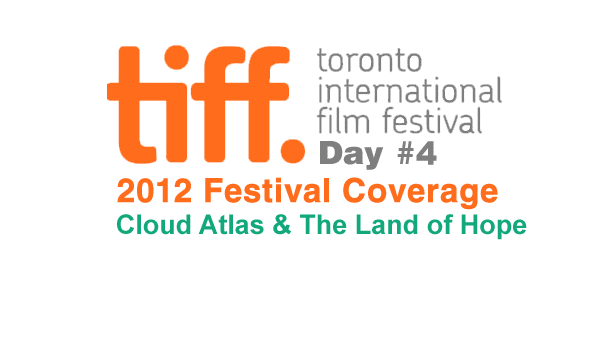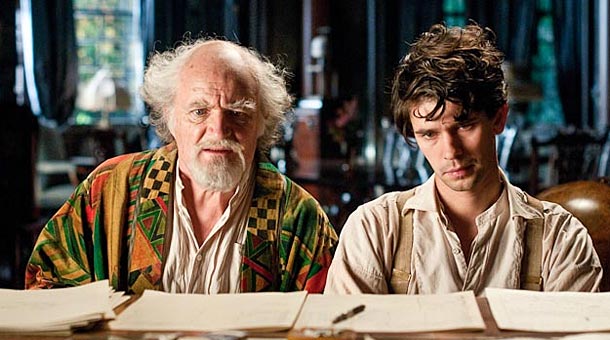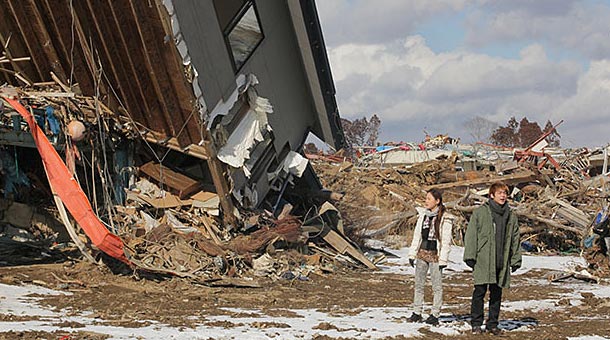TIFF 2012 Day 4: Cloud Atlas & The Land of Hope

A shorter day compared to yesterday’s 4 films, but just as fulfilling. Starting off I was afraid that Cloud Atlas would be a terrible film to watch after getting 4 hours of sleep. Before I start hearing cries from people about how this site is about indie films, let me clear something up. Cloud Atlas was independently financed with a $100 million budget, with Warner Brothers only offering distribution. Once you see Cloud Atlas you’ll understand why the thing had to be made outside of the studio system. Using six different storylines with each one taking place at different time periods (the 1800s, 1930s, 1970s, 2012, 2144 and thousands of years in the future), the movie uses its ensemble cast throughout each segment to emphasize its themes of reincarnation and the cycle of life. It’s a massive undertaking from directors Tom Tykwer and the Wachowskis (Andy and Lana) which they amazingly pull off for the most part. Cloud Atlas is a massive, sprawling piece of work that puts the spectacle back into big budget films. The radical structure of the book is dropped for the film, with all six stories cross cutting each other. There have been complaints of the movie being too messy or confusing, but the structure is no worse than an episode of Game of Thrones. And while Cloud Atlas has its flaws, there are plenty of moments where I found myself seeing the big picture and fully realizing the weight of every storyline linking to one another throughout time. That alone makes Cloud Atlas a success, and worthy of exposure to the largest audience possible.
RATING: 7.5/10

Cloud Atlas
I followed Cloud Atlas with Sion Sono’s The Land of Hope. As a longtime fan of Sono’s work I came away from this film disappointed. Last year Sono was one of the first filmmakers to address Japan’s disastrous tsunami with Himizu, which used a teenage boy’s coming of age story as a symbol for Japan’s identity crisis after enduring another massive tragedy. While Himizu‘s immediacy made the film feel like an open wound as characters tried to understand what happened to them, The Land of Hope goes into the opposite direction. Using a more restrained style, Sono observes a family who get separated after another earthquake and tsunami hit the country. The family lives near a nuclear power plant, and we follow the parents as they stubbornly fight to stay while their son and daughter-in-law become paranoid of radiation exposure after re-locating. Sono, who is usually a master of pacing, takes his time here. The result is a mostly boring film, with melodramatic scenes that feel too staged and mawkish to earn any emotional response. Eventually The Land of Hope feels like it’s simply trudging along its bloated 140 minute length, with another subplot involving a neighbor going nowhere and the main family’s struggles creating a feeling of total indifference. The ending is a big eye roller too, as one of the characters states the movie’s message which could basically be summed up as “All you need is love.” Sion Sono is a total workhorse (he couldn’t make it to my screening because he was in the middle of shooting another film), and it’s a given that his work is hit and miss. Unfortunately, The Land of Hope is a total miss despite its heavy subject matter.
RATING: 5/10

The Land of Hope
NEXT UP: Nothing! Well, just for one day as I take a break before diving back in with Berberian Sound Studio.
Recap of some of my Tweets from today:
Follow @WayTooIndie for full coverage of the 2012 Toronto International Film Festival!
Say hello to the directors of CLOUD ATLAS #TIFF12 twitter.com/WayTooIndie/st…
— Way Too Indie (@WayTooIndie) September 9, 2012
CLOUD ATLAS: Welp, they did it. Huge epic, it’s faults are overshadowed by its huge ambitions. #TIFF12
— Way Too Indie (@WayTooIndie) September 9, 2012
THE LAND OF HOPE: Sion Sono tries his hand at a ‘serious’ film and suffers for it. Probably the first film of his I’d call boring. #TIFF12
— Way Too Indie (@WayTooIndie) September 9, 2012
